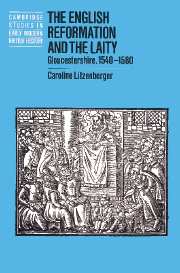Book contents
- Frontmatter
- Contents
- List of figures
- List of tables
- Acknowledgments
- Abbreviations and conventions
- Introduction
- 1 Setting the scene
- 2 Gloucestershire in the 1530s
- 3 The new diocese of Gloucester (1540–1546)
- 4 The advent of Edwardian Protestantism (1547–1553)
- 5 A return to the old religion (1553–1558)
- 6 The early years of Elizabeth's reign (1559–1569)
- 7 The clarification of the religious settlement (1570–1580)
- Conclusion
- Appendix A Sources and methodology
- Appendix B Results of wills analysis
- Appendix C Parish finances
- Bibliography
- Index
- Cambridge Studies in Early Modern British History
Appendix A - Sources and methodology
Published online by Cambridge University Press: 23 November 2009
- Frontmatter
- Contents
- List of figures
- List of tables
- Acknowledgments
- Abbreviations and conventions
- Introduction
- 1 Setting the scene
- 2 Gloucestershire in the 1530s
- 3 The new diocese of Gloucester (1540–1546)
- 4 The advent of Edwardian Protestantism (1547–1553)
- 5 A return to the old religion (1553–1558)
- 6 The early years of Elizabeth's reign (1559–1569)
- 7 The clarification of the religious settlement (1570–1580)
- Conclusion
- Appendix A Sources and methodology
- Appendix B Results of wills analysis
- Appendix C Parish finances
- Bibliography
- Index
- Cambridge Studies in Early Modern British History
Summary
Through the careful analysis of a large quantity of material on Gloucestershire, it is possible to create a picture of the past which accommodates a significant degree of variety and complexity. The evidence on which this study is based includes wills, as well as parish, diocesan and state records, and surviving contemporaneous furnishings and decorations in the parish churches of the diocese. In particular, this study includes two parish case studies with the attendant reconstitution of the parochial leadership network for each, and a detailed theological and statistical analysis of the religious content of wills. Furthermore, the types of extant evidence has determined the amount of attention which can be given to different groups of Gloucestershire inhabitants. The middling sort and the more prominent townspeople, in particular, have the principal roles, while the bishops and other clergy and the gentry also receive attention. Meanwhile, people from the lower orders of society are relegated to ‘bit parts’ in the drama. However, even within these parameters religious beliefs and practices can vary significantly. David Palliser has asserted that lay religion ‘can only with difficulty be forced into the strait-jacket of “Catholic” and “Protestant” labels’; indeed, humanity is much too complex for such simple categorisation. An historical view which is derived from mountains of minutiae is likely to accommodate such complexity more easily than one which is fundamentally anecdotal. Rich and interesting accounts of specific incidents can then be used effectively to enliven that view. In addition, in the use of detailed data I have delayed categorisations or generalisations until the last possible moment in the analytical process to avoid concealing evidence of diversity and to allow as much variety and complexity as possible to emerge in this representation of the past.
- Type
- Chapter
- Information
- The English Reformation and the LaityGloucestershire, 1540–1580, pp. 168 - 178Publisher: Cambridge University PressPrint publication year: 1997



